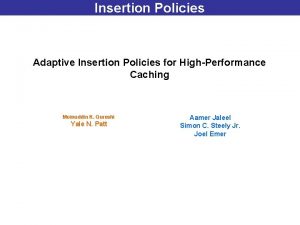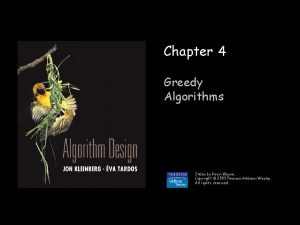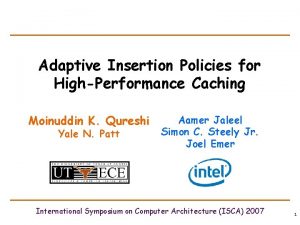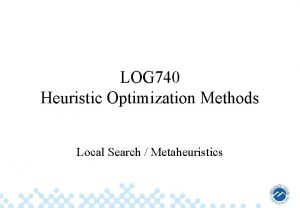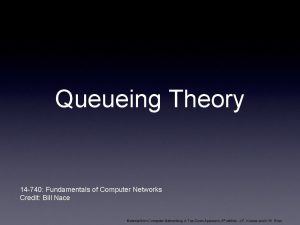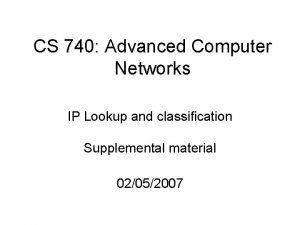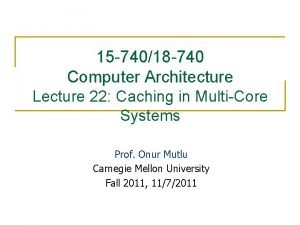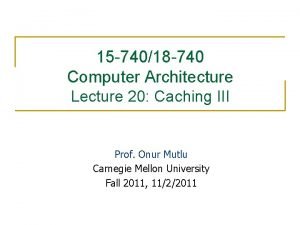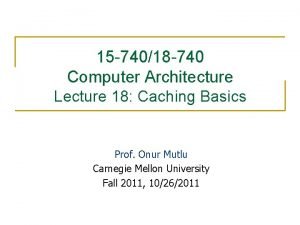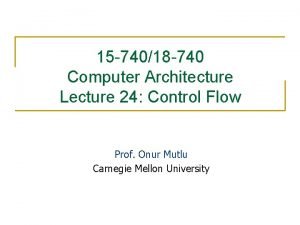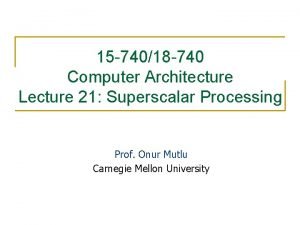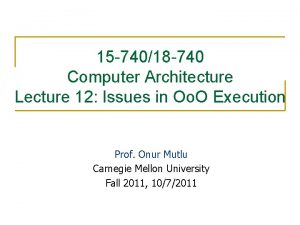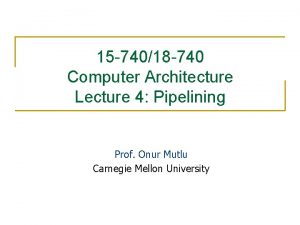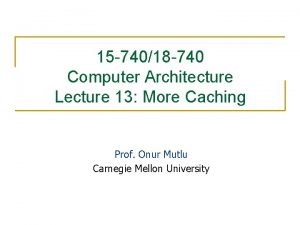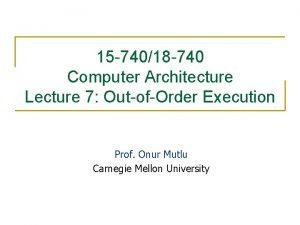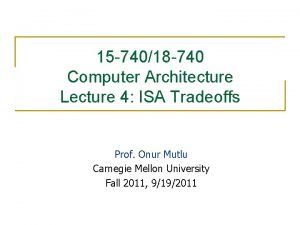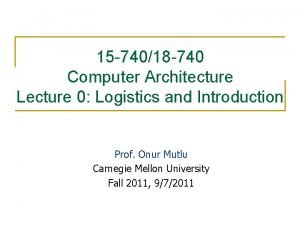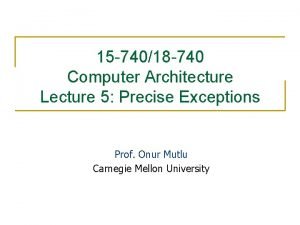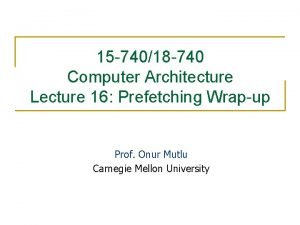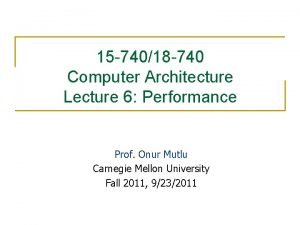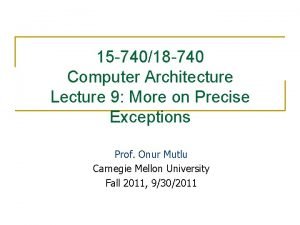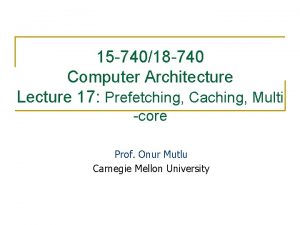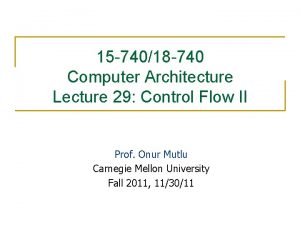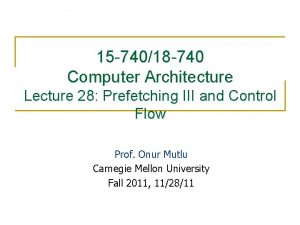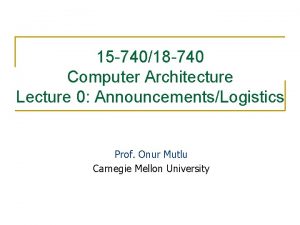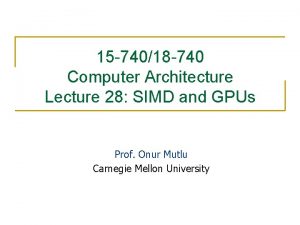15 74018 740 Computer Architecture Lecture 18 Caching




























- Slides: 28

15 -740/18 -740 Computer Architecture Lecture 18: Caching in Multi-Core Prof. Onur Mutlu Carnegie Mellon University

Last Time n Multi-core issues in prefetching and caching q q q Prefetching coherence misses: push vs. pull Coordinated prefetcher throttling Cache coherence: software versus hardware Shared versus private caches Utility based shared cache partitioning 2

Readings in Caching for Multi-Core n Required q n Qureshi and Patt, “Utility-Based Cache Partitioning: A Low. Overhead, High-Performance, Runtime Mechanism to Partition Shared Caches, ” MICRO 2006. Recommended (covered in class) q q Lin et al. , “Gaining Insights into Multi-Core Cache Partitioning: Bridging the Gap between Simulation and Real Systems, ” HPCA 2008. Qureshi et al. , “Adaptive Insertion Policies for High. Performance Caching, ” ISCA 2007. 3

Software-Based Shared Cache n Assume no hardware support (demand based cache sharing, i. e. Management n n LRU replacement) How can the OS best utilize the cache? Cache sharing aware thread scheduling q Schedule workloads that “play nicely” together in the cache n n E. g. , working sets together fit in the cache Requires static/dynamic profiling of application behavior Fedorova et al. , “Improving Performance Isolation on Chip Multiprocessors via an Operating System Scheduler, ” PACT 2007. Cache sharing aware page coloring q Dynamically monitor miss rate over an interval and change virtual to physical mapping to minimize miss rate n Try out different partitions 4

OS Based Cache Partitioning n n n Lin et al. , “Gaining Insights into Multi-Core Cache Partitioning: Bridging the Gap between Simulation and Real Systems, ” HPCA 2008. Cho and Jin, “Managing Distributed, Shared L 2 Caches through OSLevel Page Allocation, ” MICRO 2006. Static cache partitioning q q n Predetermines the amount of cache blocks allocated to each program at the beginning of its execution Divides shared cache to multiple regions and partitions cache regions through OS-based page mapping Dynamic cache partitioning q q q Adjusts cache quota among processes dynamically Page re-coloring Dynamically changes processes’ cache usage through OSbased page re-mapping 5

Page Coloring n n n Physical memory divided into colors Colors map to different cache sets Cache partitioning q Ensure two threads are allocated pages of different colors Memory page Cache Way-1 ………… Way-n Thread A Thread B 6

Page Coloring • Physically indexed caches are divided into multiple regions (colors). • All cache lines in a physical page are cached in one of those regions (colors). Physically indexed cache Virtual address OS control Physical address page offset virtual page number Address translation physical page number Page offset = OS can control the page color of a virtual page through address mapping (by selecting a physical page with a specific value in its page color bits). Cache address Cache tag Set index page color bits Block offset ……

Static Cache Partitioning using Page Coloring Physical pages are grouped to page bins according to their page color … i i+1 i+2 … OS address mapping 1 2 3 4 Physically indexed cache … …… … Shared cache is partitioned between two…… processes through address mapping. Process 1 . . . 1 2 3 4 Cost: Main memory space needs to be partitioned, too. … i i+1 i+2 … Process 2 … …… ……

Dynamic Cache Partitioning via Page Re. Coloring Allocated colors color 0 1 2 Pages of a process are organized into linked lists by their colors. Memory allocation guarantees that pages are evenly distributed into all the lists (colors) to avoid hot points. 3 …… N-1 n Page re-coloring: q q page color table q Allocate page in new color Copy memory contents Free old page

Dynamic Partitioning in Dual Core Init: Partition the cache as (8: 8) finished No Yes Exit Run current partition (P 0: P 1) for one epoch Try one epoch for each of the two neighboring partitions: (P 0 – 1: P 1+1) and (P 0 + 1: P 1 -1) Choose next partitioning with best policy metrics measurement (e. g. , cache miss rate)

Experimental Environment n Dell Power. Edge 1950 q q q n Two-way SMP, Intel dual-core Xeon 5160 Shared 4 MB L 2 cache, 16 -way 8 GB Fully Buffered DIMM Red Hat Enterprise Linux 4. 0 q q q 2. 6. 20. 3 kernel Performance counter tools from HP (Pfmon) Divide L 2 cache into 16 colors

Performance – Static & Dynamic Lin et al. , “Gaining Insights into Multi-Core Cache Partitioning: Bridging the Gap between Simulation and Real Systems, ” HPCA 2008.

Software vs. Hardware Cache Management n Software advantages + No need to change hardware + Easier to upgrade/change algorithm (not burned into hardware) n Disadvantages - Less flexible: large granularity (page-based instead of way/block) - Limited page colors reduced performance per application (limited physical memory space!), reduced flexibility - Changing partition size has high overhead page mapping changes - Adaptivity is slow: hardware can adapt every cycle (possibly) - Not enough information exposed to software (e. g. , number of misses due to inter-thread conflict) 13

Handling Shared Data in Private Caches n Shared data and locks ping-pong between processors if caches are private -- Increases latency to fetch shared data/locks -- Reduces cache efficiency (many invalid blocks) -- Scalability problem: maintaining coherence across a large number of private caches is costly n How to do better? q Idea: Store shared data and locks only in one special core’s cache. Divert all critical section execution to that core/cache. n n Essentially, a specialized core for processing critical sections Suleman et al. , “Accelerating Critical Section Execution with Asymmetric Multi-Core Architectures, ” ASPLOS 2009. 14

Non-Uniform Cache Access n n Large caches take a long time to access Wire delay q Closeby blocks can be accessed faster, but furthest blocks determine the worst-case access time Idea: Variable latency access time in a single cache Partition cache into pieces q q Each piece has different latency Which piece does an address map to? n Static: based on bits in address n Dynamic: any address can map to any piece q q n How to locate an address? Replacement and placement policies? Kim et al. , “An adaptive, non-uniform cache structure for wire-delay dominated on-chip caches, ” ASPLOS 2002. 15

Multi-Core Cache Efficiency: Bandwidth Filters n Caches act as a filter that reduce memory bandwidth requirement q q q n Cache hit: No need to access memory This is in addition to the latency reduction benefit of caching GPUs use caches to reduce memory BW requirements Efficient utilization of cache space becomes more important with multi-core q Memory bandwidth is more valuable n Pin count not increasing as fast as # of transistors q q n 10% vs. 2 x every 2 years More cores put more pressure on the memory bandwidth How to make the bandwidth filtering effect of caches better? 16

Revisiting Cache Placement (Insertion) n Is inserting a fetched/prefetched block into the cache (hierarchy) always a good idea? q q n No allocate on write: does not allocate a block on write miss How about reads? Allocating on a read miss -- Evicts another potentially useful cache block + Incoming block potentially more useful n Ideally: q q we would like to place those blocks whose caching would be most useful in the future we certainly do not want to cache never-to-be-used blocks 17

Revisiting Cache Placement (Insertion) n Ideas: q Hardware predicts blocks that are not going to be used n q Software (programmer/compiler) marks instructions that touch data that is not going to be reused n n Lai et al. , “Dead Block Prediction, ” ISCA 2001. How does software determine this? Streaming versus non-streaming accesses q q If a program is streaming through data, reuse likely occurs only for a limited period of time If such instructions are marked by the software, the hardware can store them temporarily in a smaller buffer (L 0 cache) instead of the cache 18

Reuse at L 2 Cache Level (%) Do. A Lines Do. A Blocks: Blocks unused between insertion and eviction For the 1 MB 16 -way L 2, 60% of lines are Do. A Ineffective use of cache space 19

Why Dead on Arrival Blocks? q Streaming data Never reused. L 2 caches don’t help. art Cache size in MB Misses per 1000 instructions q Working set of application greater than cache size mcf Cache size in MB Solution: if working set > cache size, retain some working set 20

Cache Insertion Policies: MRU vs. LRU MRU a LRU b c d e f g h Reference to ‘i’ with traditional LRU policy: i a b c d e f g g i Reference to ‘i’ with LIP: a b c d e f Choose victim. Do NOT promote to MRU Lines do not enter non-LRU positions unless reused 21

Other Insertion Policies: Bimodal Insertion LIP does not age older lines Infrequently insert lines in MRU position Let e = Bimodal throttle parameter if ( rand() < e ) Insert at MRU position; else Insert at LRU position; For small e , BIP retains thrashing protection of LIP while responding to changes in working set 22

Analysis with Circular Reference Model Reference stream has T blocks and repeats N times. Cache has K blocks (K<T and N>>T) Two consecutive reference streams: Policy LRU (a 1 a 2 a 3 … a. T)N (b 1 b 2 b 3 … b. T)N 0 0 OPT (K-1)/T LIP (K-1)/T 0 BIP (small e) ≈ (K-1)/T For small e , BIP retains thrashing protection of LIP while adapting to changes in working set 23

Analysis with Circular Reference Model 24

LIP and BIP Performance vs. LRU BIP(e=1/32) (%) Reduction in L 2 MPKI LIP Changes to insertion policy increases misses for LRU -friendly workloads 25

Dynamic Insertion Policy (DIP) n Qureshi et al. , “Adaptive Insertion Policies for High. Performance Caching, ” ISCA 2007. Two types of workloads: LRU-friendly or BIP-friendly DIP can be implemented by: 1. Monitor both policies (LRU and BIP) 2. Choose the best-performing policy 3. Apply the best policy to the cache Need a cost-effective implementation Set Sampling 26

Dynamic Insertion Policy Miss Rate DIP (32 dedicated sets) (%) Reduction in L 2 MPKI BIP 27

DIP vs. Other Policies (LRU+RND) (LRU+LFU) (LRU+MRU) DIP OPT Double(2 MB) 28
 Architecture lecture notes
Architecture lecture notes Isa vs microarchitecture
Isa vs microarchitecture Web content caching and distribution
Web content caching and distribution Adaptive insertion policies for high performance caching
Adaptive insertion policies for high performance caching Hadoop hdfs latency
Hadoop hdfs latency 4greedy
4greedy Peranganing tembung ingkang mungel sakecap kawastanan
Peranganing tembung ingkang mungel sakecap kawastanan Adaptive insertion policies for high performance caching
Adaptive insertion policies for high performance caching Asc 740
Asc 740 Fas 109 accounting for income taxes
Fas 109 accounting for income taxes Deloitte asc 740
Deloitte asc 740 740
740 Gabriel deloitte
Gabriel deloitte Onur mutlu computer architecture
Onur mutlu computer architecture Public law 740 passed by congress
Public law 740 passed by congress 14-740
14-740 F 740
F 740 Dell 740r
Dell 740r Cs 740
Cs 740 01:640:244 lecture notes - lecture 15: plat, idah, farad
01:640:244 lecture notes - lecture 15: plat, idah, farad Bus architecture in computer organization
Bus architecture in computer organization Difference between computer organisation and architecture
Difference between computer organisation and architecture Complete computer description in computer organization
Complete computer description in computer organization Computer security 161 cryptocurrency lecture
Computer security 161 cryptocurrency lecture Computer-aided drug design lecture notes
Computer-aided drug design lecture notes The architecture business cycle
The architecture business cycle Call and return architecture in software engineering
Call and return architecture in software engineering Modular vs integral product architecture
Modular vs integral product architecture Integral product architecture
Integral product architecture



